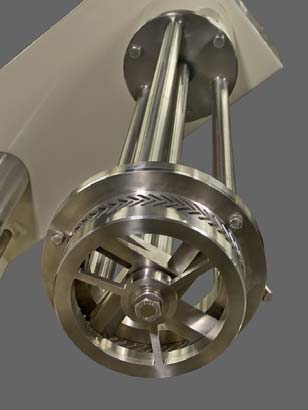Tech Report
Simplified production of fine solid dispersions

Technology Brief
This bulletin discusses anew technology for producing stable dispersions of solids in liquid. Ultra-high shear mixers such as the Ross PreMax utilize specially engineered rotor/stators that can deliver extremely fine particle size distributions faster and more cost-effectively than conventional milling devices.
Conventional dispersion equipment
Different types of mixing and milling equipment are used to disperse solids into liquid depending on the characteristics of the raw materials and the mixture itself. The type/grade of solids to be dispersed, maximum and final viscosity of the dispersion, desired level of fineness, shear-sensitivity and temperature limits are some factors generally considered when selecting equipment and designing a process.
For example, the classic high speed disperser is a standard tool used for incorporating powders into a relatively low viscosity liquid vehicle (< 50,000cP). Typically equipped with an open disc blade with a sharp saw-tooth periphery, the high speed disperser breaks down weak agglomerates and effectively wets the individual dry particles that are released. This simple and cost-effective device can produce uniform and stable dispersions of powders that tend to wet-out easily, whether inherently or as a result of pre-treatment or addition of dispersing agents. However, when dealing with solid particles that form more strongly bonded agglomerates, the disperser is often used as a"pre-mixer" with the objective of preparing a rough dispersion which is then fed into a higher energy device like a media mill, roller mill or grinder to reach the target particle size distribution. This conventional method of production entails multiple transfer steps, very long cycle times and intensive clean-up.
Ultra-high shear mixing vs. milling
A new solution to the production of fine solid dispersions comes in the form of ultra-high shear mixers which are essentially rotor/stator devices designed to impart intense hydraulic shear energy into a flowable product. Extending the processing capability of traditional batch mixers from simple powder wet-out to intensive deagglomeration, an ultra-high shear mixer can offer significant improvements to a normally slow and operator-intensive dispersion process.
The benefits of "pre-mixing" and milling in a single tank are obvious: lower processing costs, accelerated cycle times, simplified clean-up and material handling, to name a few. In cases where ultra-high shear mixing does not necessarily eliminate milling but reduces the number of mill passes, the resulting two-stage process still offers substantial benefits in terms of improved throughput and maximized utilization of the milling equipment.
Delta rotor/stator technology
One such ultra-high shear mixer is the Ross PreMax with Delta rotor/stator technology (US Patent No.6,000,840). Running at tip speeds as high as 5,000 fpm within a close tolerance stator, the Delta rotor is precisely contoured for high pumping capacity and shear intensity. Product is drawn from above and below the rotor then expelled radially through the stator slots at high velocity. Compared to other batch style mixers including high speed dispersers, traditional rotor/stator mixers and immersion mills, the PreMax delivers more superior particle size reduction.
Other ultra-high shear mixer alternatives
In addition to the Ross PreMax, inline ultra-high shear mixers are also available or use in continuous or recirculation mode. Take advantage of laboratory testing services and trial/rental programs to confirm if your specific application can be finished in an ultra-high shear mixer.
Sample Application: Electronic Coatings

A manufacturer of electronic grade coatings was previously using media mills to produce fine carbon black dispersions. A typical cycle time for one media mill was around 12 hours, not counting the pre-mix operation. After switching to the PreMax, the same amount of finished product was finished in 35 minutes, from powder wet-out to the final fineness of grind.